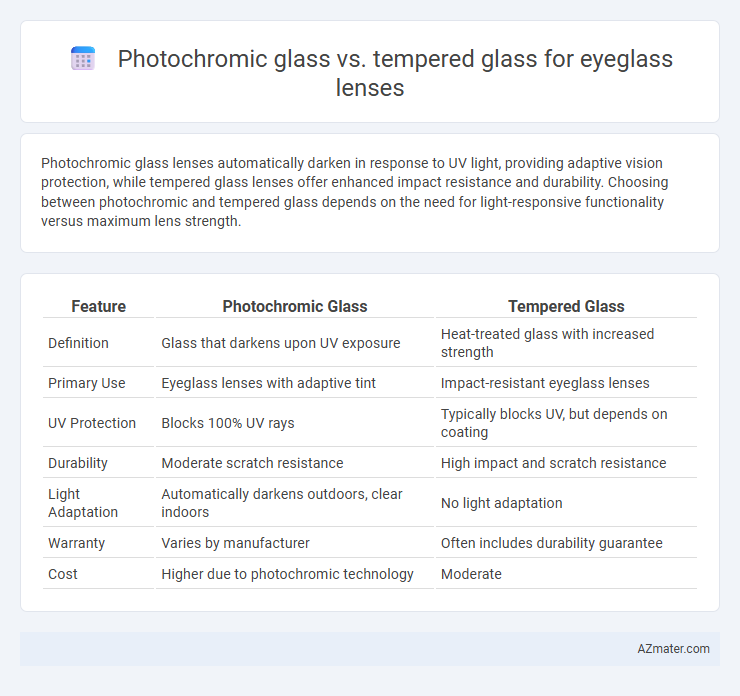Photochromic glass lenses automatically darken in response to UV light, providing adaptive vision protection, while tempered glass lenses offer enhanced impact resistance and durability. Choosing between photochromic and tempered glass depends on the need for light-responsive functionality versus maximum lens strength.
Table of Comparison
| Feature | Photochromic Glass | Tempered Glass |
|---|---|---|
| Definition | Glass that darkens upon UV exposure | Heat-treated glass with increased strength |
| Primary Use | Eyeglass lenses with adaptive tint | Impact-resistant eyeglass lenses |
| UV Protection | Blocks 100% UV rays | Typically blocks UV, but depends on coating |
| Durability | Moderate scratch resistance | High impact and scratch resistance |
| Light Adaptation | Automatically darkens outdoors, clear indoors | No light adaptation |
| Warranty | Varies by manufacturer | Often includes durability guarantee |
| Cost | Higher due to photochromic technology | Moderate |
Introduction to Photochromic and Tempered Glass Lenses
Photochromic lenses darken automatically in response to UV light, providing convenient adaptation from indoor to outdoor environments while protecting eyes from harmful rays. Tempered glass lenses undergo a thermal or chemical treatment process to increase strength and resistance to impact, making them highly durable and safer against breakage. Both lens types offer unique benefits: photochromic lenses enhance visual comfort with dynamic tinting, whereas tempered glass lenses deliver superior toughness and scratch resistance.
What is Photochromic Glass?
Photochromic glass is a type of eyeglass lens that darkens automatically when exposed to UV light, offering protection against sunlight by adjusting its tint based on environmental conditions. Unlike tempered glass, which is heat-treated to enhance strength and resistance to impact, photochromic lenses provide dynamic light filtering that improves visual comfort and reduces eye strain. These lenses are ideal for individuals seeking adaptive eyewear that transitions seamlessly between indoor clarity and outdoor sun protection.
What is Tempered Glass for Eyeglasses?
Tempered glass for eyeglasses is a type of safety glass that undergoes controlled thermal or chemical treatments to increase its strength compared to standard glass lenses. This process ensures that if broken, the glass shatters into small, blunt pieces rather than sharp shards, reducing the risk of injury. Tempered glass lenses offer enhanced durability and impact resistance, making them a preferred choice for protective eyewear and everyday use.
Key Differences Between Photochromic and Tempered Glass Lenses
Photochromic glass lenses automatically darken in response to UV light, providing convenience and protection from glare, while tempered glass lenses are designed primarily for durability and impact resistance. Photochromic lenses offer variable tinting for changing light conditions, whereas tempered glass lenses maintain a constant clarity and are more resistant to scratches and breakage. The choice depends on whether adaptive light filtering or enhanced lens strength is the priority for eyewear users.
Light Adaptation: Photochromic vs Tempered Glass
Photochromic glass lenses dynamically adjust tint based on ultraviolet light exposure, providing seamless light adaptation by darkening in bright sunlight and clearing indoors. Tempered glass lenses, known for their impact resistance and durability, do not change their optical properties in response to light, offering consistent clarity but no automatic protection against glare or UV rays. The smart transition feature of photochromic lenses enhances visual comfort and reduces eye strain, making them superior for variable lighting conditions compared to static tempered glass lenses.
Durability and Impact Resistance Compared
Photochromic glass offers moderate durability with the added benefit of lens color changing in response to UV light, enhancing visual comfort outdoors, but it is generally more prone to scratching compared to tempered glass. Tempered glass lenses provide superior impact resistance and durability, making them ideal for high-impact environments or activities requiring robust eyewear protection. When comparing durability and impact resistance, tempered glass is the preferred option for safety and longevity, while photochromic glass excels in adaptability to changing light conditions.
UV Protection and Eye Safety
Photochromic glass lenses offer dynamic UV protection by darkening in response to sunlight, effectively blocking 100% of harmful UVA and UVB rays to reduce eye strain and prevent long-term damage. Tempered glass lenses provide enhanced impact resistance and durability, improving eye safety against physical hazards but do not inherently filter UV radiation. Combining photochromic technology with tempered glass can maximize both UV protection and mechanical strength, ensuring comprehensive eye safety in diverse environments.
Weight and Comfort in Eyeglass Lenses
Photochromic glass lenses offer superior comfort by reducing eye strain through automatic tint adjustment in varying light conditions, while tempered glass lenses provide enhanced durability and impact resistance but tend to be heavier, potentially causing discomfort during extended wear. The weight of tempered glass lenses can lead to pressure on the nose and ears, whereas photochromic glass, often made from lighter plastic materials such as polycarbonate or Trivex, ensures a more comfortable fit for all-day use. Choosing photochromic lenses improves overall comfort by combining lightweight properties with adaptive light filtering, making them ideal for users prioritizing eye comfort and reduced lens weight.
Cost and Availability Analysis
Photochromic glass lenses generally cost 20-30% more than tempered glass lenses due to advanced light-reactive technology. Tempered glass lenses are widely available and preferred for their durability and affordability, making them a budget-friendly option for eyeglass wearers. Photochromic lenses are often stocked in fewer retail locations, limiting immediate accessibility compared to the more common tempered glass variants.
Which Lens Type is Best for Your Needs?
Photochromic glass lenses automatically darken in response to UV light, offering convenience for outdoor use and reducing eye strain by adapting to changing light conditions. Tempered glass lenses provide superior impact resistance and durability, making them ideal for high-activity environments or safety requirements. Choosing between photochromic and tempered glass depends on your lifestyle needs--opt for photochromic lenses for versatile light adaptation and tempered lenses for enhanced protection and longevity.

Infographic: Photochromic glass vs Tempered glass for Eyeglass lens
 azmater.com
azmater.com